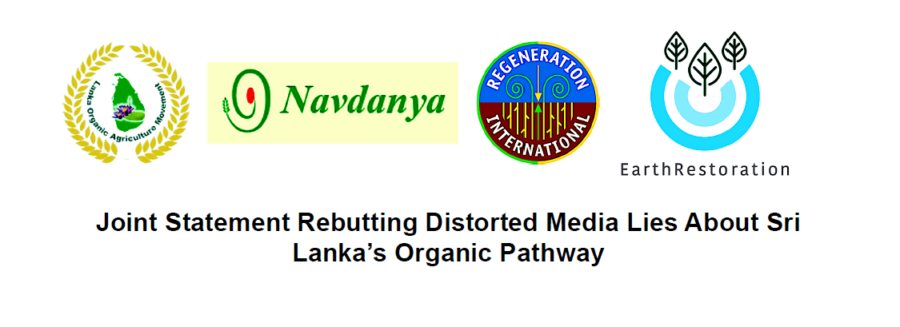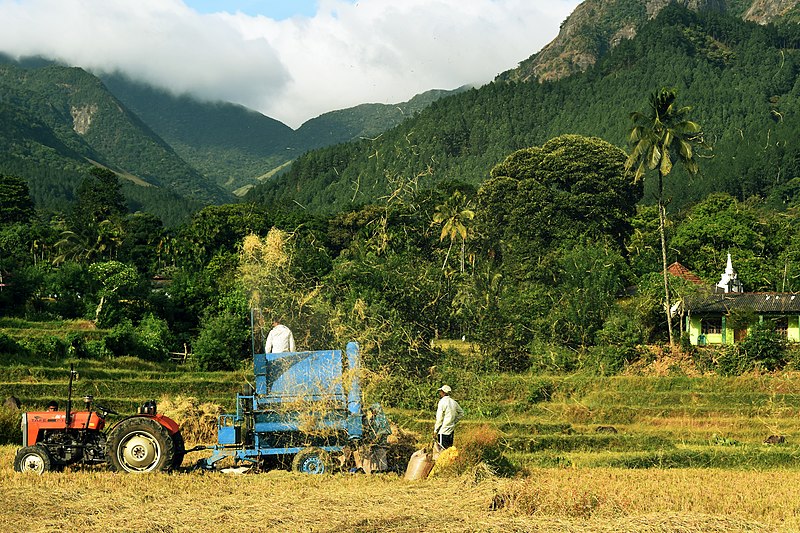Navdanya and Regeneration International, together with two Sri Lankan organizations, the Lanka Organic Agriculture Movement (LOAM) and Earth Restoration, released a joint statement in October 2023 responding to allegations in the international press that the switch to organic farming has plunged Sri Lanka into economic chaos.
Joint Statement Rebutting Distorted Media Lies About Sri Lanka’s Organic Pathway
Agribusiness cartels and media articles stated that Sri Lanka’s economic chaos was caused by the government forcing the country to go organic.
These articles’ familiar false narratives, untruths, and language style show spin doctors wrote them from a PR company employed by pesticide/big agriculture cartels. They were cut and pasted by poor-quality journalists who did not fact-check.
The narrative was that the government forced farmers to become organic by banning chemical fertilizers. This caused crop failures and food shortages, which caused the riots causing economic chaos.
This is a gross distortion of the truth by falsely connecting dots. The economic chaos was not caused by the country going organic, as it hadn’t gone organic. The government was only planning to do so in the future.
Sri Lanka’s Economic Troubles
Sri Lanka was in severe economic trouble due to the build-up of financial debt caused by a combination of factors that began with the crippling financial drain, infrastructure damage, and social disruption of the decades-long civil war.
On top of this, tax cuts in 2019 reduced government revenue and deepened that country’s national debt. The 2020 Covid-19 pandemic decimated the tourism industry. All these factors caused a significant increase in inflation, contributing to shortages of food and essential goods and increasing food insecurity in Sri Lanka. Sri Lanka was in severe economic and social trouble by the beginning of 2021.
The Import and Export Control Department banned the importation of chemical fertilizers on April 27, 2021, because they contributed over $400 million to the trade deficit. This was the start of a range of measures that would be proposed to create an economic recovery.
Organic Agriculture was not the Cause of Sri Lanka’s Economic Chaos.
The ban on chemical fertilizers and agrochemicals was not to turn Sri Lanka into an organic country; it was to reduce Sri Lanka’s crippling national debt. A presidential task force was formed to develop a green, climate change-resilient economy of which organic agriculture was one aspect.
Sir Lanka never implemented a national organic transition program, so the campaign to blame the collapse of its economy on organic agriculture is pure misinformation based on a series of lies fed by a PR company to poor-quality journalists who did not fact-check.
The Rice Miller Oligarchies were Contributors to the Chaos
The traditional withholding of rice stocks and the artificial increases of prices that the rice miller oligarchies manufacture every year after the primary harvest season created artificial shortages that contributed to the chaos that started riots. Other contributing factors resulted from fuel and essential items shortages and excessive inflation, making everything more expensive and unaffordable.
Transitioning to Organic
The sudden reduction of fertilizer caused a decline in rice production. However, this was not because the country went organic. It takes three years to transition a farm to organic and decades to transition a country or region, as in the cases of the successful transitions of Bhutan and Sikkim. Just stopping chemical fertilizers does not make a farm organic. Cuba successfully transitioned to organic agriculture when fertilizers and oil were blockaded.
The national and international organic sectors advised the Sri Lankan Government to develop plans to manage the transition to organic and advised against the sudden cessation of fertilizers and agrochemicals. A plan was never developed for Sri Lanka, although a few proposals were started to begin the process that would require several years to implement.
Organic agriculture is not a system of neglect. Stopping chemical fertilizers and toxic agrochemicals does not make a farm organic. Organic agriculture has a variety of management systems to increase soil fertility and effectively manage weeds, pests, and diseases. These take years to develop, one of the reasons for a three-year transition period to achieve organic certification.
Higher Yields with Organic Agriculture
Transitioning to organic does not have to decrease yields. Best practice organic systems are getting equal to higher yields than industrial and agricultural systems, especially in developing countries like Sri Lanka.
Noémi Nemes from the United Nations Food and Agriculture Organization (FAO) analyzed over 50 economic studies. She stated that the data: “… demonstrates that, in most cases, organic systems are more profitable than non-organic systems. Higher market prices and premiums, lower production costs, or a combination of the two generally result in higher relative profits from organic agriculture in developed countries. The same conclusion can be drawn from studies in developing countries, but there, higher yields combined with high premiums are the underlying causes of their relatively greater profitability.“
The critical issue is that organic agriculture provides a higher income and yields in developing countries. Yields can be significantly increased by teaching farmers to add science-based regenerative and organic practices to their traditional methods.
Increases in Rice Production
Rice is the most important staple food crop in Sri Lanka. There is ample evidence that rice production and profitability can increase with regenerative and organic agriculture based on the science of agroecology.
A research project conducted in the Philippines by MASIPAG found that the yields of organic rice were similar to industrial systems. The research project significantly compared the income between similar-sized industrial and organic farms and found that the average income for organic farms was 150% higher than for industrial farms.
The improvements in the science and practices of the System of Rice Intensification (SRI) using regenerative and organic systems are getting impressive yields higher than the average for chemical fertilizer systems.
Professor Uphoff from Cornell University states: “SRI methods have often enabled poor farmers to double, triple, or even quadruple their yields, not just individually but on a village level, without purchasing new varieties or agrochemical inputs.”
The Future
The new Sri Lankan Government is working with the Lanka Organic Agriculture Movement (LOAM), Earth Restoration, and other stakeholders to develop a plan to implement organic agriculture.
The transition program is essential because of the current exceptionally high prices for synthetic fertilizers and the poor exchange value of the Sri Lankan currency; most farmers cannot afford these fertilizers. They are going into deep debt when they use them or have reduced yields by not using them because they haven’t been taught effective alternatives.
Adopting best-practice organic and regenerative systems based on the science of agroecology will ensure good yields and higher incomes for farmers without these expensive and toxic chemicals.
The world will have to transition to fossil fuel-free organic agriculture to address climate change since industrial agriculture and fossil fuel emissions are significant drivers of climate change.
Navdanya and Regeneration International will continue supporting the Sri Lankan organic movement in achieving this critical outcome.
Thilak Kariyawasam, Lanka Organic Agriculture Movement (LOAM), https://loam.lk
Dr. Ranil Senanayake, EarthRestoration, https://restore.earth
Dr. Vandana Shiva, Navdanya, http://www.navdanya.com
Dr. Andre Leu, Regeneration International, www.regenerationinternational.org







